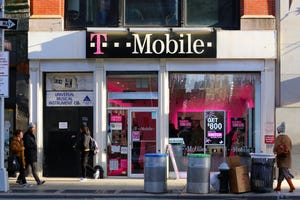Panasonic Tunes Out Tru2way TVs
Tru2way's retail pursuits hang by a thread, though hope may be found in 'set-back' boxes that can be paired with TVs via HDMI

The tru2way TV experiment appears to be over now that Panasonic Corp. (NYSE: PC) has reportedly scrubbed its line of widescreen TVs with tru2way built-in.
Panasonic got as far as getting two tru2way models certified at CableLabs , which, in turn, were sold on a limited basis in tandem with Comcast Corp. (Nasdaq: CMCSA, CMCSK) in Denver, Chicago, and Atlanta. Among them, the 42-inch and 50-inch models were available at the Circuit City store in Highlands Ranch, Colo., before the retail chain went belly up. The brochure was nice. (See Denver, Chicago First to Get Tru2way TVs and Tru2Way in Atlanta.)
But those days appear to be over for now. “We currently have no tru2way products at retail and there are no announced release dates for Panasonic tru2way retail products at this time,” Panasonic told Multichannel News, which reported it Thursday.
Panasonic's decision pretty much spells the end of the idea of integrating tru2way (and its OpenCable Application Platform middleware stack) directly into digital televisions. Samsung Electronics Co. Ltd. (Korea: SEC), which leases tru2way-based boxes to MSOs such as Time Warner Cable Inc. (NYSE: TWC) and Bright House Networks , has had several tru2way, LCD TV models certified at CableLabs, but none has reached retail, and none is expected to.
One of the big issues is costs. It's long been held that it costs TV manufacturers at least $200 to add tru2way, but Panasonic tells Multichannel News that it was closer to $300. [Ed. note: We've asked the CE giant to confirm that figure.]
On top of that, TV makers have bemoaned the challenges of integrating tru2way into TVs and making that investment without really knowing if the products will even sell. Others have completely steered clear because of the licensing requirements. TiVo Inc. (Nasdaq: TIVO), which is making a tru2way-based guide but no boxes based on the platform, has been one of the tru2way's fiercest critics for many of the reasons stated above. (See TiVo Gives Cable Both Barrels and TiVo Building tru2way Version of New Interface.)
US MSO support for tru2way is far from universal, so consumer electronics firms have been reluctant to place big bets at retail on a geographically challenged product. "What if one system has [tru2way] and another one doesn't?" asks a source who's familiar with the tru2way market and why its retail ambitions have thus far failed. (See Tru2way's Retail Forecast: Cloudy .)
More set-backs (the good kind)
Panasonic's move means tru2way's retail future is hanging by a thread, but it doesn’t necessarily spell the end. Panasonic and other vendors are developing new "set-back" tru2way boxes that should be less expensive to make, easier to integrate, and offer TV makers much more flexibility. Instead of baking tru2way into the set, TV makers can pair their sets with hideaway boxes that connect and communicate via HDMI (High Definition Multimedia Interface) cables and target those offerings to cable markets where tru2way is supported.
Panasonic has been showing off its set-back prototype at recent shows and has developed a tru2way-based HD-DVR box for Comcast that will be leased to customers rather than sold at retail. Panasonic has not revealed when its set-back box will be launched or indicated whether it will use it at retail or sell it directly to MSOs. Comcast, meanwhile, is still testing the company's tru2way-based HD-DVR. (See CableLabs Clears Panasonic Tru2way Box.)
Advanced Digital Broadcast (ADB) , meanwhile, has developed a tru2way set-back model called the "Phantom" that uses standard SD High Capacity (SDHC) cards to enable a "DVR-Lite" feature. Sony Corp. (NYSE: SNE) has already shown some interest in pairing an earlier version of a CableLabs-certified ADB set-back box with its Bravia TV lineup, but nothing's reached retail yet. (See Sony Drives ADB's Set-Back and Sony-Comcast Store Has Tru2way 'Set-Back' Box .)
CableLabs has gone to the lengths of publishing specifications for a "thin chassis" tru2way set-back box, so some common technical underpinnings are there if other manufacturers decide they want to build them, too. The National Cable & Telecommunications Association (NCTA) is also advocating that HDMI-fed approach at the Federal Communications Commission (FCC) as the Commission chews on new CableCARD rules and inquires about a universal "AllVid" concept for retail gateways and adapters that can work across the pay TV landscape. (See CableLabs Specs Tru2way Set-Back Box, Cable's Got Ideas for a Universal Retail Box , FCC Floats 'Simple' Gateway, CableCARD Rules , and Cable: FCC's AllVid Goes Too Far .)
Despite the retail set-back (the bad kind) with tru2way TVs, it's still too early to stick a fork in tru2way as a common interactive platform for the larger cable ops. Several of the top incumbent US cable operators have invested heavily in tru2way headend upgrades, with some, including Cox Communications Inc. and Cablevision Systems Corp. (NYSE: CVC), already having that part of the job done. Cox is using tru2way and a guide based on the platform as the centerpiece of a new premium video services package that includes multi-room DVRs. (See Revealed: The Tru2way MOU and Cox Guides Tru2way Forward.)
Comcast, meanwhile, reported to the FCC last month that almost 90 percent of its headends were tru2way-ready and recently signed NDS Ltd. as its "prime integrator" for tru2way. (See Comcast, NDS Connect on Tru2way and Comcast Closing Tru2way Gap .)
— Jeff Baumgartner, Site Editor, Light Reading Cable
About the Author(s)
You May Also Like












